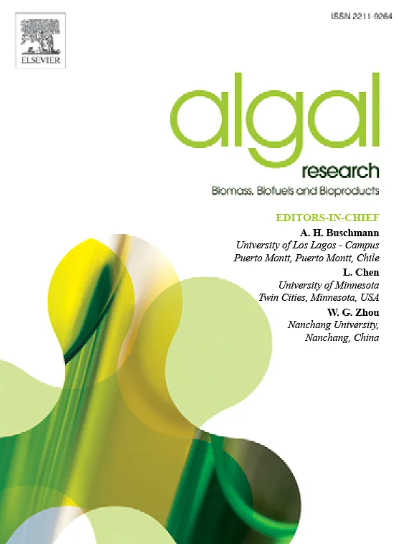在盐碱环境下,联合施用固氮蓝藻可提高水稻的生长和营养品质
IF 4.6
2区 生物学
Q1 BIOTECHNOLOGY & APPLIED MICROBIOLOGY
Algal Research-Biomass Biofuels and Bioproducts
Pub Date : 2025-04-22
DOI:10.1016/j.algal.2025.104061
引用次数: 0
摘要
盐碱地因盐胁迫和肥力降低而严重影响水稻种植。本研究探讨了固氮蓝藻水青藻(Anabaena azotica)和固氮蓝藻(polypothrix tenuis)在盐碱环境下促进水稻生长和品质的潜力。通过盆栽试验监测水稻分蘖、抽雄和成熟期各主要生殖阶段生理参数——株高、叶绿素含量和叶面积指数,并评价收获后稻米品质。结果表明,蓝藻处理的应用,特别是两种处理的组合,显著提高了水稻的生理生长指标和综合品质。其中,组合处理的株高和叶片总叶绿素含量分别比对照提高了4.42%和19.46%。移栽初期,固氮蓝藻处理组丙二醛(MDA)含量较对照降低40.01%。但过氧化物酶(POD)和过氧化氢酶(CAT)活性显著升高,表明胁迫耐受性提高。由于蛋白质含量的提高和必需氨基酸(如亮氨酸、苯丙氨酸、赖氨酸和精氨酸)水平的提高,营养质量得到改善。综上所述,固氮蓝藻是一种有前途的、绿色的、可持续的改善盐碱地水稻生长和品质的方法。施用蓝藻可部分替代化肥,恢复土壤健康。这有助于恢复退化土地上的作物生产能力,并为提高农业可持续性和抵御力提供了有效途径。本文章由计算机程序翻译,如有差异,请以英文原文为准。
Combined application of nitrogen-fixing cyanobacteria enhances rice growth and nutritional quality in saline environments
Saline soils severely affect rice cultivation due to salt stress and reduced fertility. This study investigates the potential of Anabaena azotica and Tolypothrix tenuis (nitrogen-fixing cyanobacteria) to improve the growth and quality of rice in saline environments. Potting experiments were conducted to monitor rice growth indices including plant height, chlorophyll content, and leaf area index, which are physiological parameters at all major reproductive stages (Tillering, Tasseling, and Maturity), and assessed post-harvest rice quality. The results showed that the application of cyanobacterial treatments, particularly the combination of the two species, significantly improved the physiological growth indices and overall quality of rice. Notably, under the combined treatment, plant height and leaf total chlorophyll content increased by 4.42 % and 19.46 %, respectively, compared to the control. At the early stage of transplanting, malondialdehyde (MDA) content in the treatment group with nitrogen-fixing cyanobacteria was 40.01 % lower than that of control. However, the activities of peroxidase (POD) and catalase (CAT) were significantly increased, which indicated improved stress tolerance. The nutritional quality improved due to higher protein content and increased levels of essential amino acids such as leucine, phenylalanine, lysine, and arginine. Conclusively, nitrogen-fixing cyanobacteria are a promising, green, and sustainable method for improving rice growth and quality in saline soils. The application of cyanobacteria can partially replace chemical fertilizers and restore soil health. This helps reactivate crop production capacity in degraded lands and provides an effective way to improve agricultural sustainability and resilience.
求助全文
通过发布文献求助,成功后即可免费获取论文全文。
去求助
来源期刊

Algal Research-Biomass Biofuels and Bioproducts
BIOTECHNOLOGY & APPLIED MICROBIOLOGY-
CiteScore
9.40
自引率
7.80%
发文量
332
期刊介绍:
Algal Research is an international phycology journal covering all areas of emerging technologies in algae biology, biomass production, cultivation, harvesting, extraction, bioproducts, biorefinery, engineering, and econometrics. Algae is defined to include cyanobacteria, microalgae, and protists and symbionts of interest in biotechnology. The journal publishes original research and reviews for the following scope: algal biology, including but not exclusive to: phylogeny, biodiversity, molecular traits, metabolic regulation, and genetic engineering, algal cultivation, e.g. phototrophic systems, heterotrophic systems, and mixotrophic systems, algal harvesting and extraction systems, biotechnology to convert algal biomass and components into biofuels and bioproducts, e.g., nutraceuticals, pharmaceuticals, animal feed, plastics, etc. algal products and their economic assessment
 求助内容:
求助内容: 应助结果提醒方式:
应助结果提醒方式:


